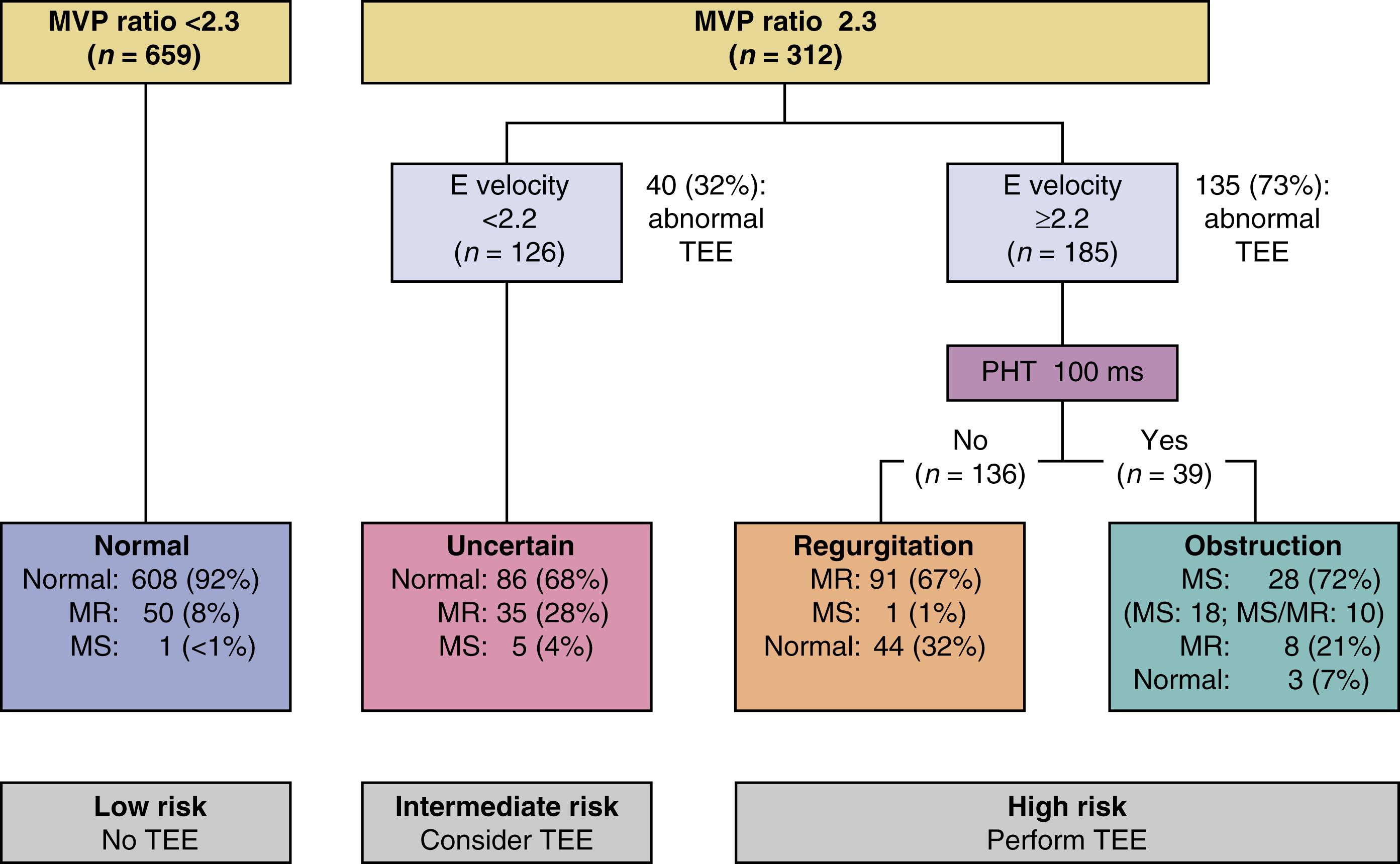Physical Address
304 North Cardinal St.
Dorchester Center, MA 02124
The authors acknowledge the contributions of Dr. Hillier, who was the author of this chapter in the previous edition.
Transthoracic echocardiography (TTE) is the essential imaging investigation for comprehensive baseline assessment and serial evaluation of mitral prosthetic valve function. It is important to understand the prosthetic valve design features to enhance interpretation of the anatomic and hemodynamic data. A standardized TTE protocol is essential in ensuring that all baseline parameters are assessed and documented during the initial postoperative assessment. Doppler examination at TTE provides accurate assessment of prosthetic valve hemodynamics but has limitations in detecting the cause of dysfunction and confirming the presence and mechanism of associated regurgitation. Because of the anatomical position of the prosthetic mitral valve, transesophageal echocardiography (TEE) provides an exceptional view of the mitral prosthesis and is essential in determining the mechanism and severity of prosthesis dysfunction in selected cases.
The two-dimensional (2D) imaging component of the TTE examination provides anatomic information on prosthetic valve structure, sewing ring stability, and the surrounding structures. The prosthetic valve type (biologic or mechanical), valve size, and date of valve replacement must be established for accurate assessment of valve function. Basic clinical data, including body weight, height, blood pressure, and heart rate and rhythm, should be documented.
Assessment of the prosthetic leaflets or mechanical occluders can be assessed after orientation of the ultrasound beam to reduce acoustic shadowing and improve diagnostic yield. If the ultrasound beam is orientated parallel to the direction of occluder opening, acoustic shadowing across the plane of the valve is reduced with resultant improvement in visualization of occluder motion. For the mitral prosthesis, this is usually achieved from the apical two- or four-chamber window views depending on the implanted orientation of the prosthesis. Intermediate imaging planes scanning through the mitral annulus may also minimize acoustic shadowing and increase the detection of annular pathologies. In addition to assessing prosthetic valve structure, TTE also provides a complete assessment of concomitant native valvular disease, atrial dimensions, and ventricular size and function.
Doppler assessment allows the noninvasive measurement of flow velocities across prosthetic valves from which valve gradients can be calculated. However, as with all stenotic lesions, valve gradients are determined by both volumetric flow and the stenotic valve area. Thus, in addition to gradients, the derivation of flow-independent parameters of prosthetic valve function such as effective orifice area (EOA), pressure halftime (PHT), and dimensionless velocity index (DVI) are essential tools used to quantify mitral prosthetic valve function and are listed in Table 111.1 .
| Peak early mitral inflow velocity (E, m/s) | Refer to valve subtype; usually <2.2 m/s |
| Mean gradient (mm Hg) | Refer to valve subtype and size; usually <5 mm Hg |
| Pressure halftime (ms) | Refer to valve subtype and size; usually <100 ms |
| Effective orifice area (cm 2 ) | (CSA LVOT × VTI LVOT ) ÷ VTI PMV Refer to valve subtype and size |
| Dimensionless velocity index (unitless) | PMV VTI /LVOT VTI ; usually <2.3 Refer to valve type and size |
The EOA is calculated using the continuity equation, which requires stroke volumes at two chosen sites (see Table 111.1 ). It is important to note that significant aortic or mitral regurgitation (MR) >grade 1/4 invalidates this method. In the presence of aortic regurgitation, the right ventricular outflow tract is an alternative method for calculating the true systemic stroke volume. EOA should always be calculated using the continuity equation method, with normal values reported for different prosthesis types , and, as a general rule, is greater than 2.0 cm 2 . Using the PHT method to derive EOA, as for native mitral stenosis, has not been validated for mitral prostheses and does not closely correlate with other measures of EOA. , However, PHT has been shown to lengthen with increasing obstruction across the prosthesis and remains a useful parameter for assessing valve function. Therefore, it is important to record the PHT and compare it with available normal values documented for the particular valve subtype and size.
The DVI is a useful flow-independent parameter of mitral prosthetic valve function. It is simple to derive requiring measurement of only two parameters (the velocity time integrals [VTIs] for the mitral prosthesis and the left ventricular outflow tract [LVOT]) and requires the absence of significant aortic regurgitation. At baseline analysis, it provides an assessment of the hemodynamic performance of a mitral prosthesis with the best performers, typically bileaflet mechanical prostheses, having lower DVI values than bioprostheses. The baseline value can be used as the prosthetic valve “fingerprint” because this value should remain constant, regardless of changes in stroke volume, unless prosthetic valve dysfunction supervenes. If prosthetic valve dysfunction develops (either obstruction or regurgitation), the DVI will increase as the mitral prosthesis VTI is elevated without a corresponding increase in LVOT VTI. DVI has been shown to be one of the best predictors of prosthetic valve dysfunction ( Fig. 111.1 ). The combination of DVI and early mitral diastolic velocity, E velocity, has been shown to improve the positive predictive value for prosthetic valve dysfunction and aid in the selection of patients to undergo further assessment with TEE.

Become a Clinical Tree membership for Full access and enjoy Unlimited articles
If you are a member. Log in here